The animal kingdom provides so much diversity that it’s almost impossible to keep track of all the different species in the world. Sometimes the distinction between close relatives is too hard to even notice. But different species often evolve in similar ways because of their environment.
We at Bright Side gathered 16 pairs of animals who are almost indistinguishable from each other at first sight in order to show you the differences between them.
1. Jaguar vs leopard
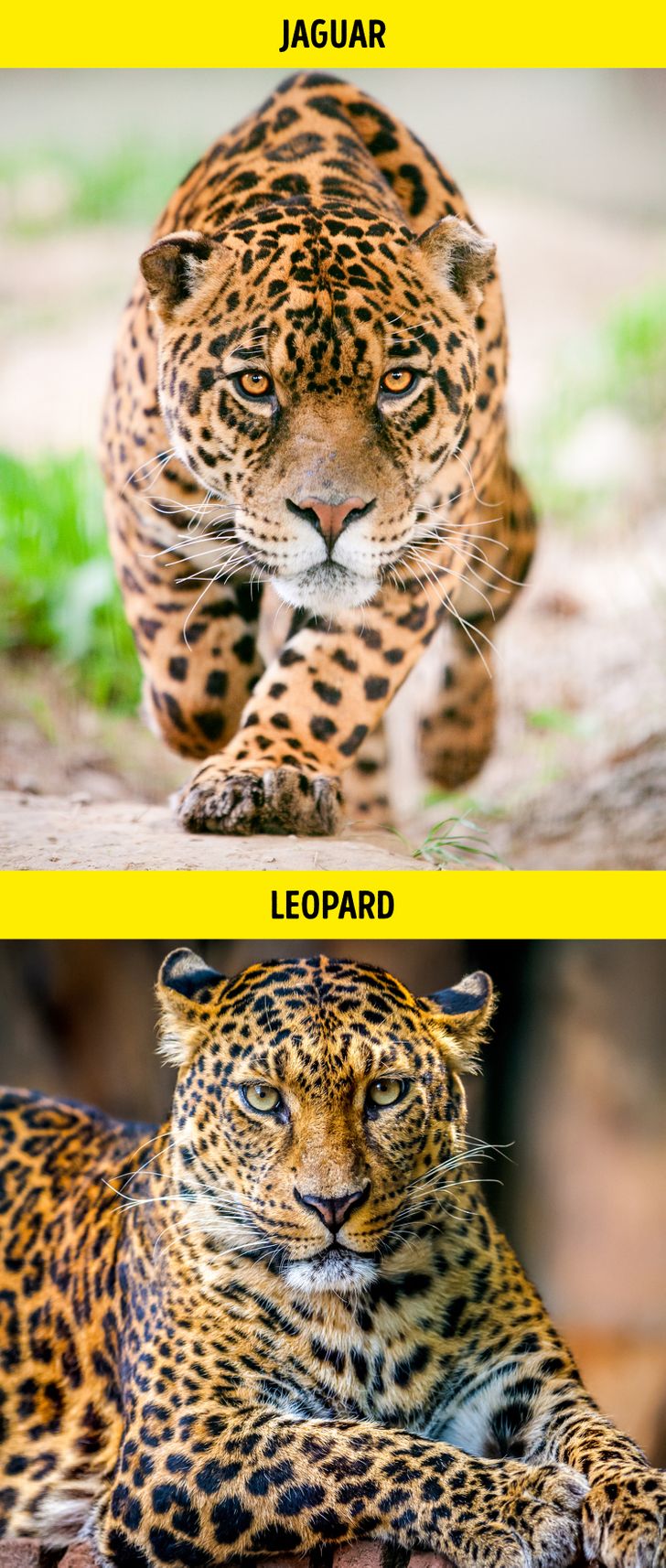
Despite their similarities, these big cats inhabit different continents and climate zones: leopards live in African savannas, while jaguars dwell in South American tropical forests. Jaguars are also larger and bulkier, and unlike leopards and many other cats, they’re fond of water.
2. Alligator vs crocodile
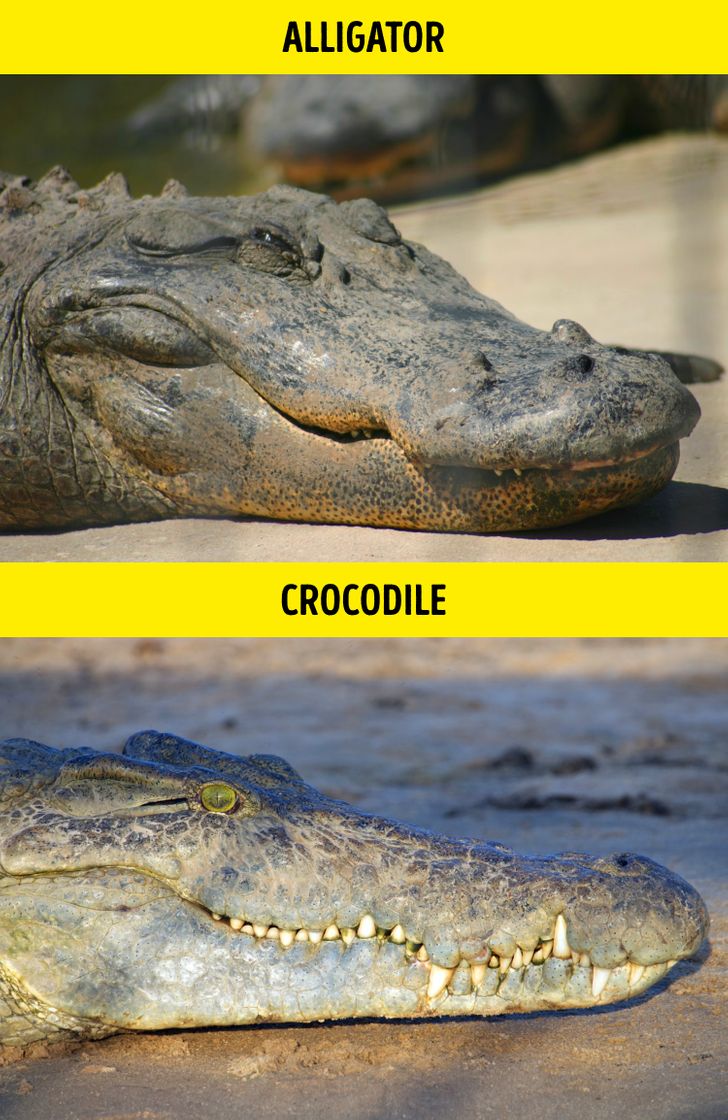
You can easily identify these 2 by the shape of their snouts: crocodiles have prominent, elongated V-shaped faces while alligators have shorter, wider U-shaped ones. Also, consider the teeth: crocodiles display their trademark toothy “grin” with every fourth tooth visible. Conversely, the alligator’s upper jaw is broader than the lower one, so its teeth aren’t visible for the most part.
3. Wasp vs hornet
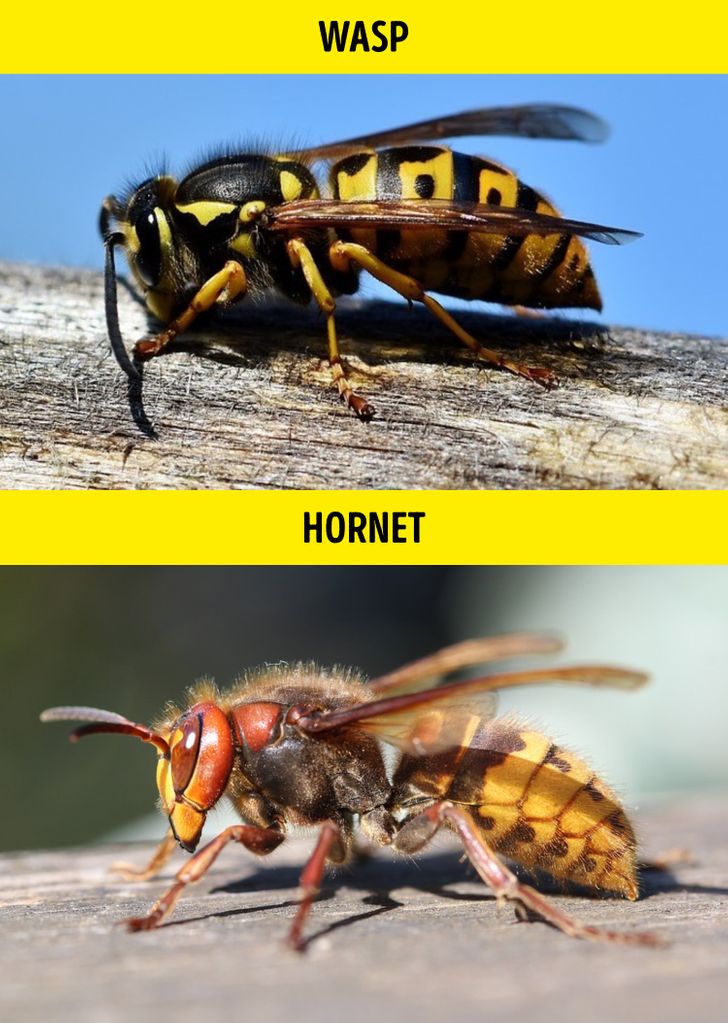
Both insects are menacing, that’s for sure. Hornets are larger and boast orange and black coloring, resembling spots rather than stripes, while wasps are more brightly colored and have yellow and black rings. You’re better off avoiding both.
4. Seal vs sea lion
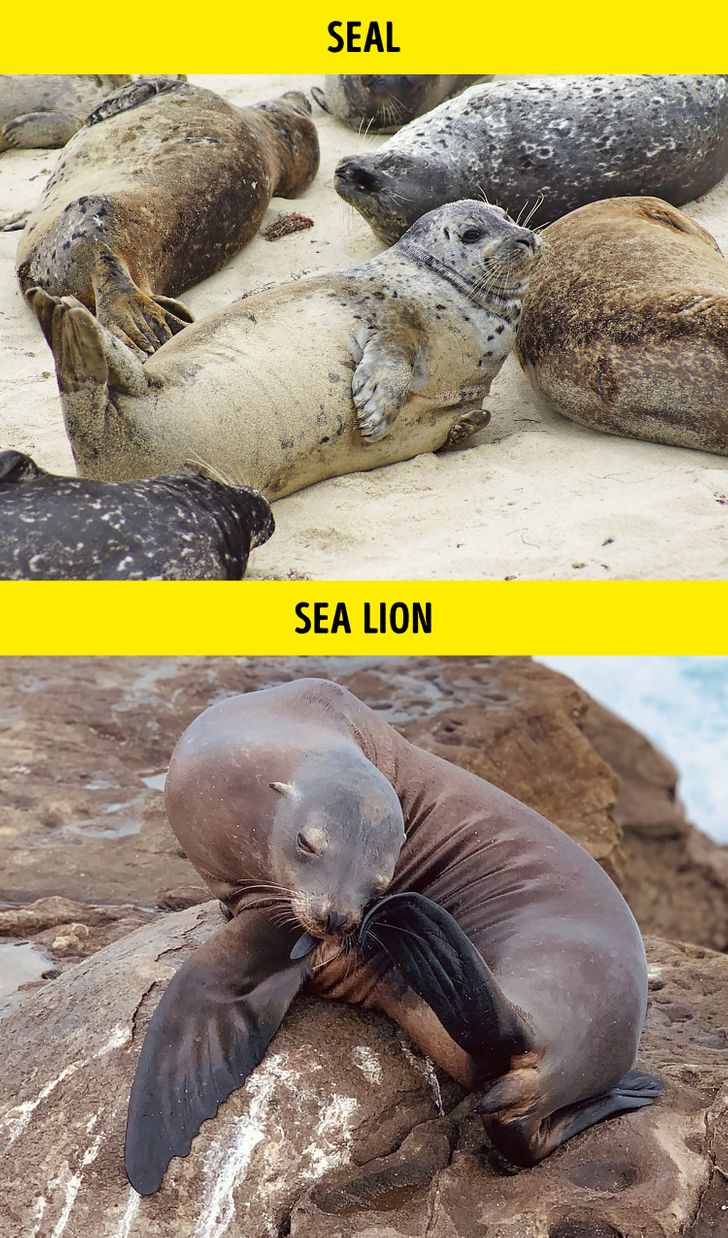
You’ve most likely met seals as cute plushy animals and sea lions as circus acrobats. Seals are covered with fur and have tiny front flippers which prevent them from walking, forcing them to wiggle on their bellies. Sea lions have smooth skin and vast flippers that they use to move on the ground.
5. Turtle vs tortoise

These 2 are both mobile (but very slow at that) and boast 4 legs. But the “turtle rock” is aquatic and has markings that resemble stains and circles on the water to better hide in the ponds. The “tortoise rock” is a land animal and spends most of its time on the ground — that is, as a literal rock.
6. Raven vs crow vs rook vs jackdaw
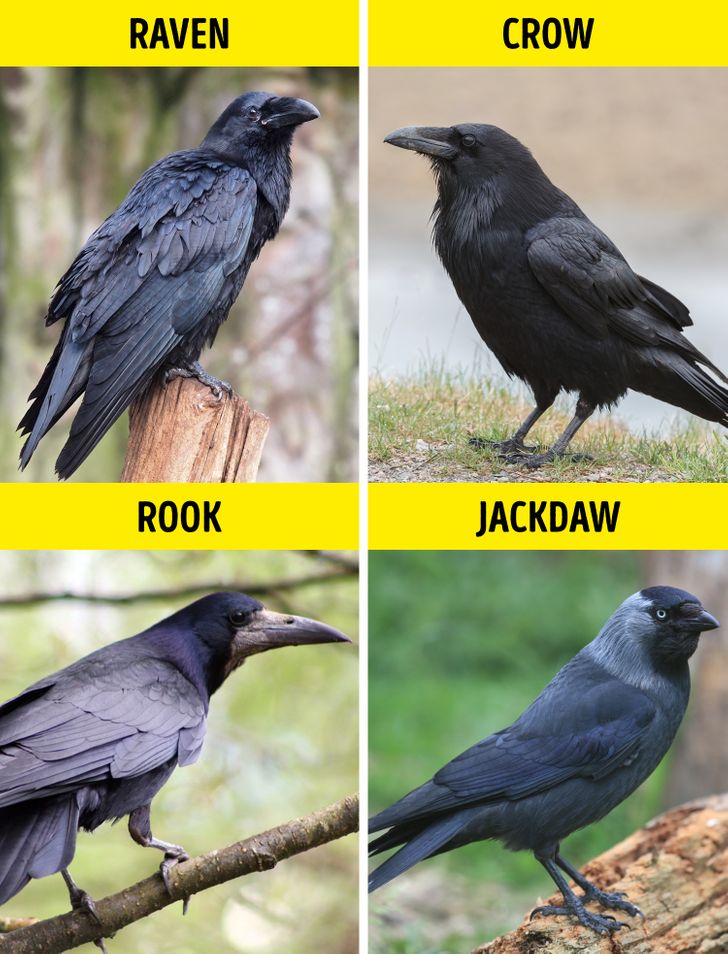
Most corvids look fairly similar (excluding jays who are like a theatre kid in a goth family). Ravens are the loftiest and most fashionable thanks to their “beard” of throat feathers. Crows and rooks are of the same size, but rooks have a distinct grey beak and fancy feather “pants” on their legs. Jackdaws are the goofiest-looking thanks to their very short beaks and a round heads with black caps.
7. Donkey vs mule
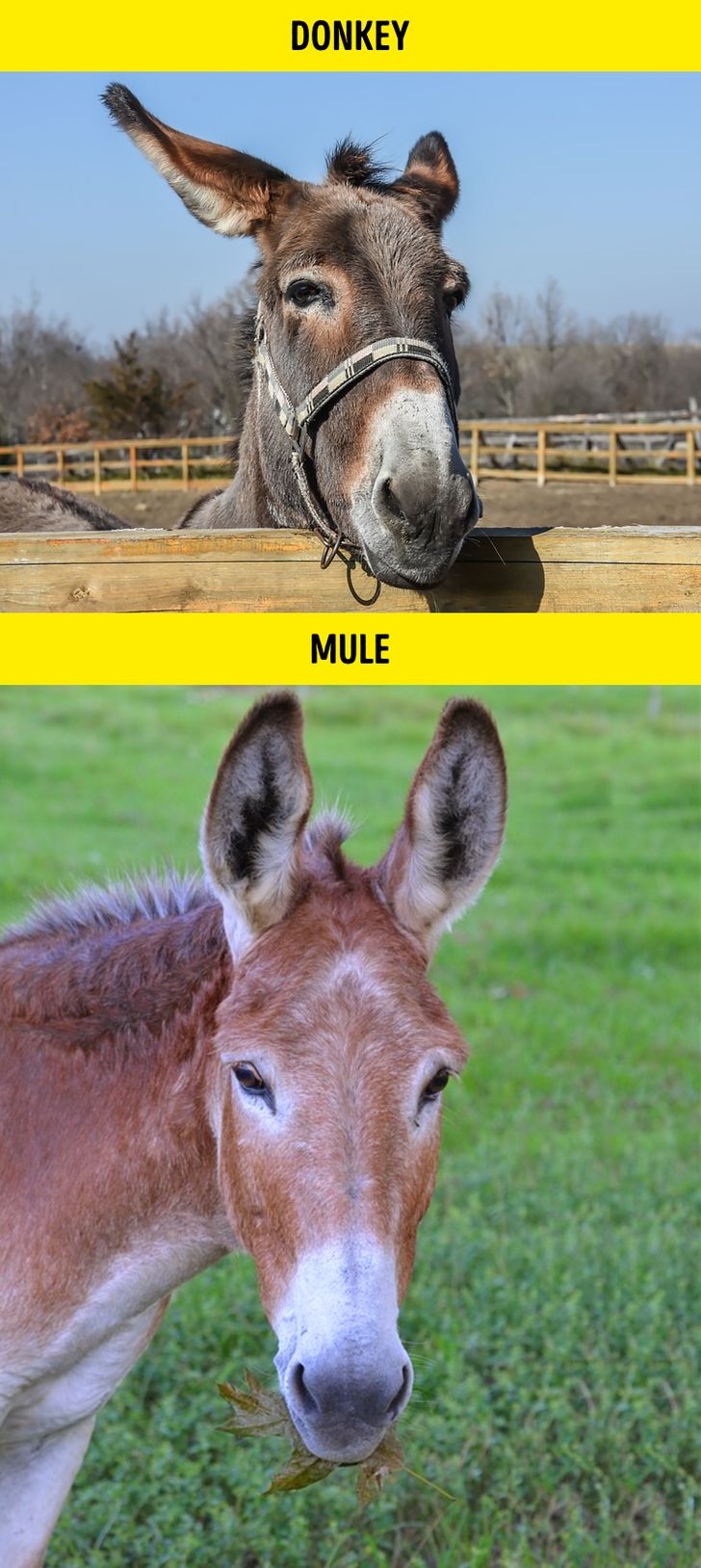
This one is tricky for a simple reason: while the donkey is its own species, a mule is a hybrid of donkey and horse. Funnily enough, it looks exactly like what you’d think these 2 animals would look like: an elegant head of a horse with ridiculously oversized donkey ears.
8. Hare vs rabbit
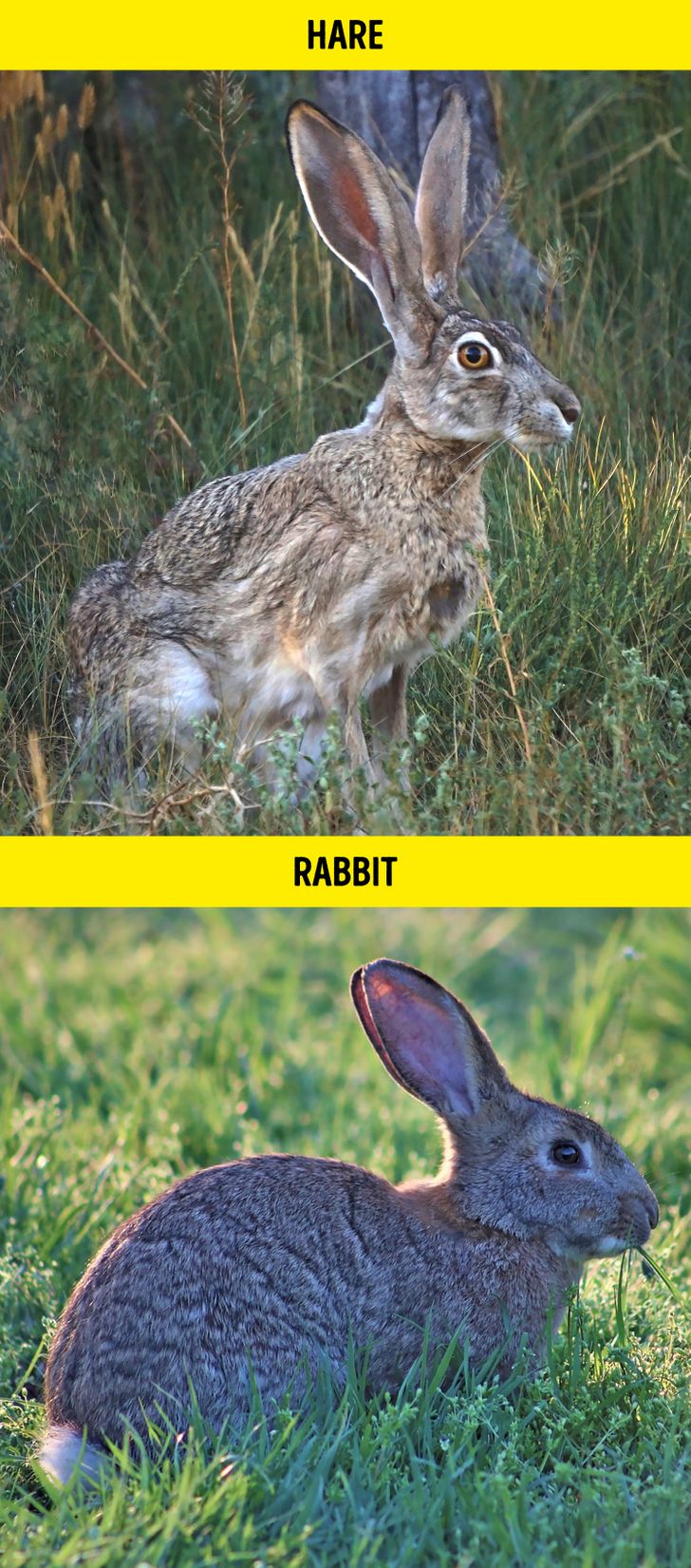
If you want a cuddly little pet, a rabbit is your best bet, but a hare definitely is not. Hares are larger and faster and have longer legs and ears. Rabbits are smaller, fluffier, and overall “cuter.” They even eat different food: rabbits prefer vegetables (like carrots) and soft grass while hares prefer bark and twigs. Rabbits are social animals while hares tend to be solitary. It’s no wonder rabbits are easily domesticated while hares mostly stay feral.
9. Moth vs butterfly
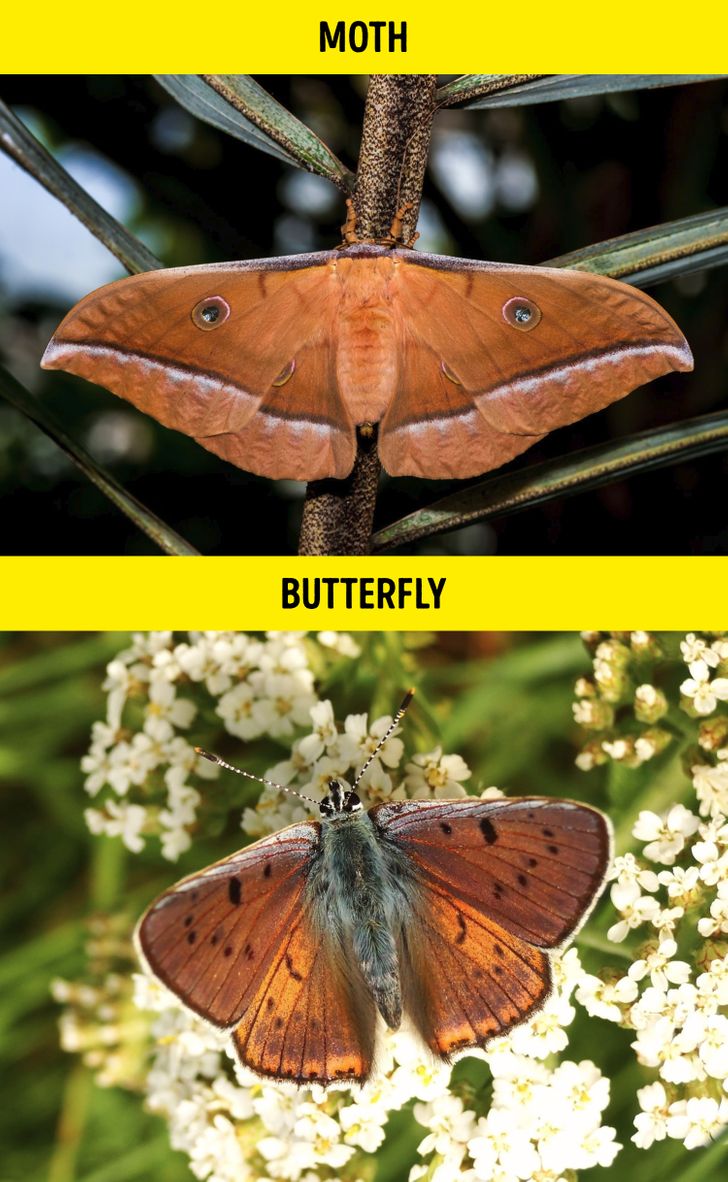
Moths have tent-like wings while butterflies flap their wings vertically. Moths usually rest with their wings open, while butterflies rest with their wings closed. Their antennas also differ: butterflies’ are long and thin and moths’ are short and feathery. Butterflies are strictly diurnal, while moths are mostly nocturnal.
10. Dolphin vs porpoise
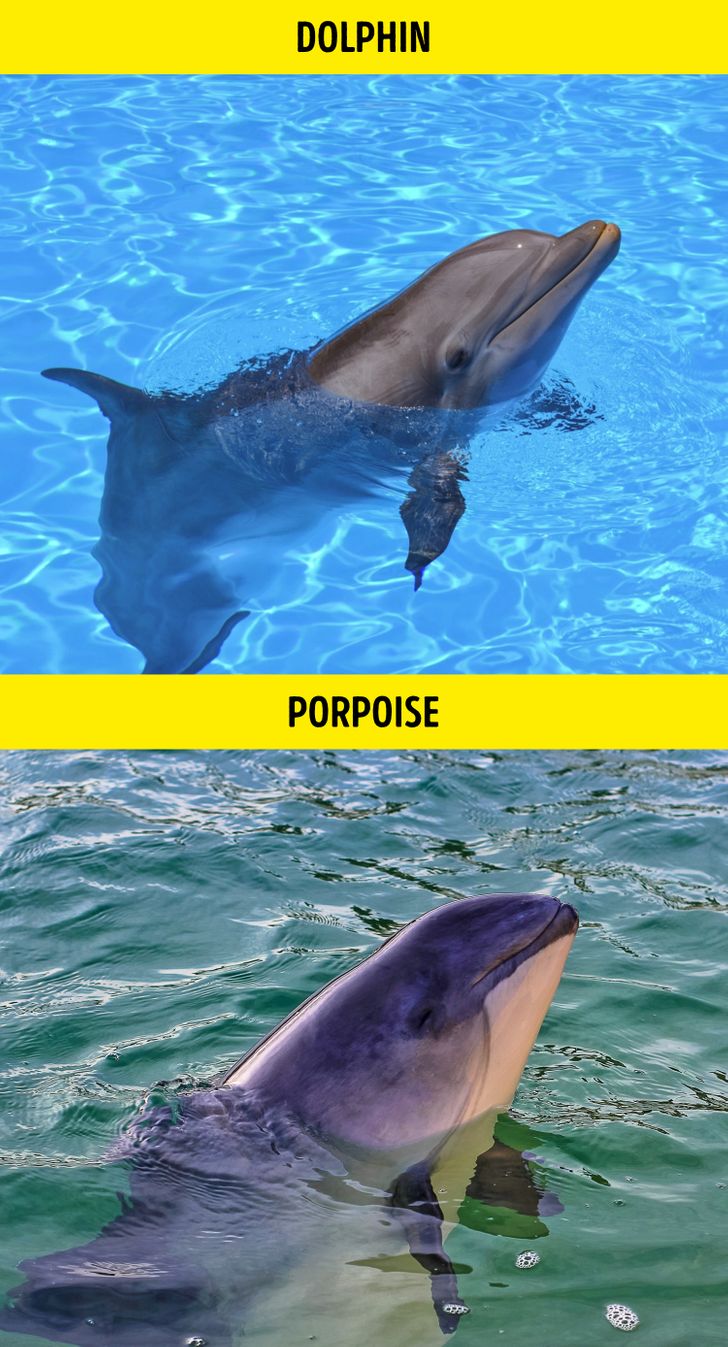
The difference between dolphins and porpoises comes down to their snouts, fins, and figures. Dolphins have long “beaks,” slender bodies, and curved dorsal fins. Porpoises have more flat, sloping faces, smaller flippers, and shorter triangular dorsal fins.
11. Weasel vs stoat
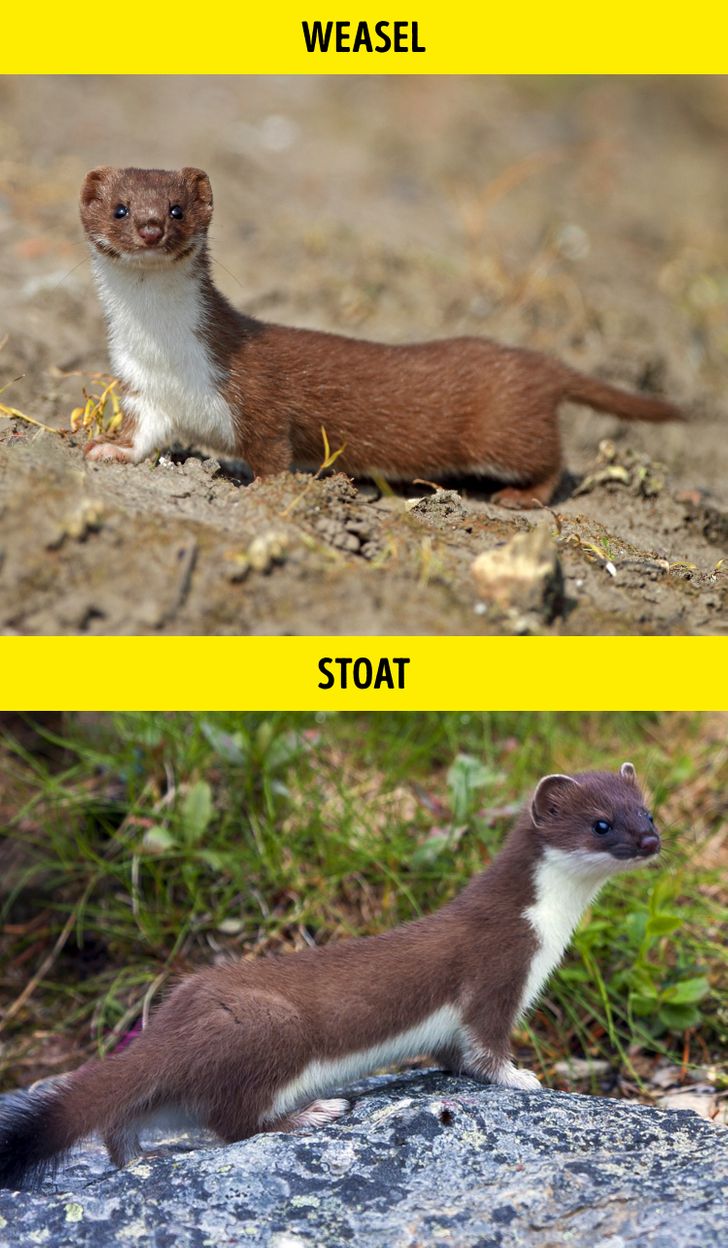
These 2 animals are close relatives. Stoats are bigger and have long tails with fuzzy black tips, while weasels’ tails are short and of the same color as the rest of the body. Stoats move in a bouncing gait with an arched back which looks hilarious, and weasels keep closer to the ground. Stoats also turn white in winter.
12. Eagle vs hawk vs falcon
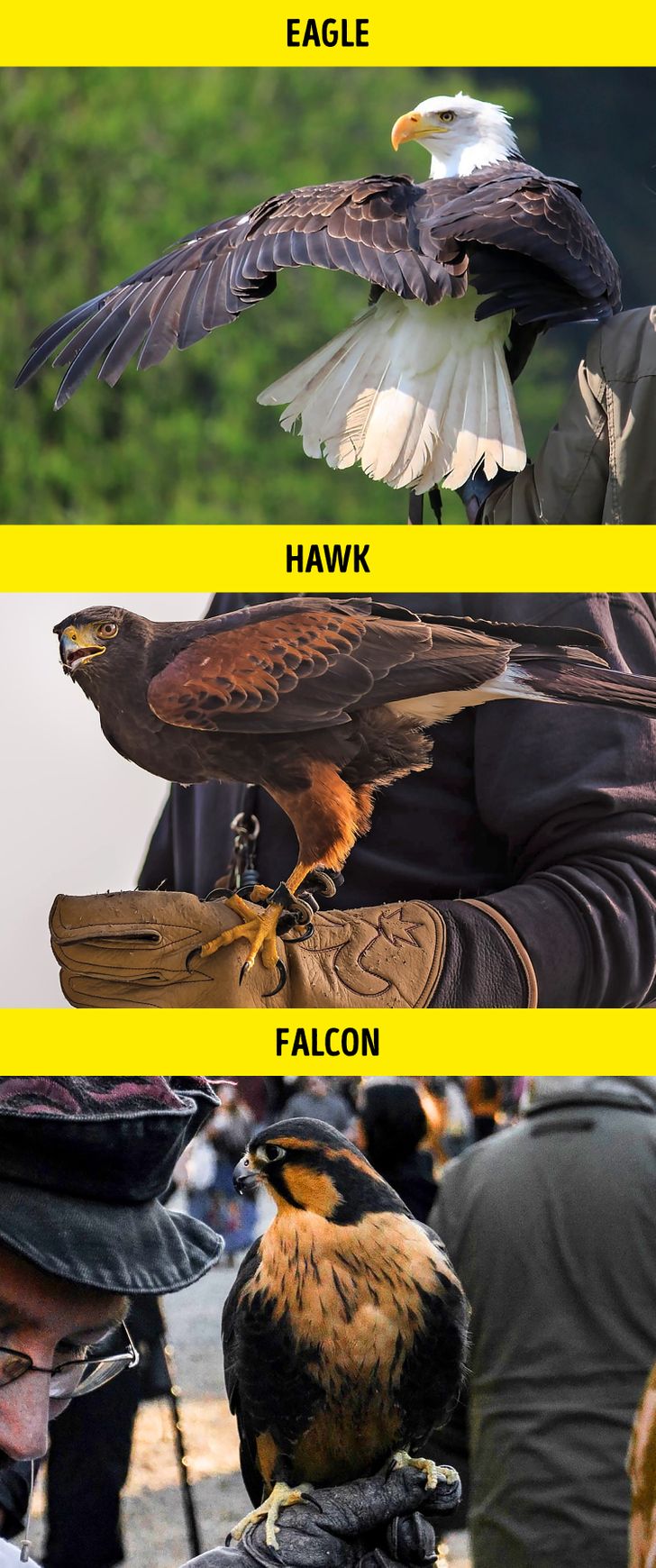
Eagles are gigantic, powerful birds who prefer to live in open spaces like cliffs and mountains. Hawks are a little smaller and more nimble in the air, capable of maneuvering in more closed areas. Falcons are the smallest and fastest of the 3 and differentiate the most visually: they have larger eyes and shorter beaks.
13. Mouse vs rat
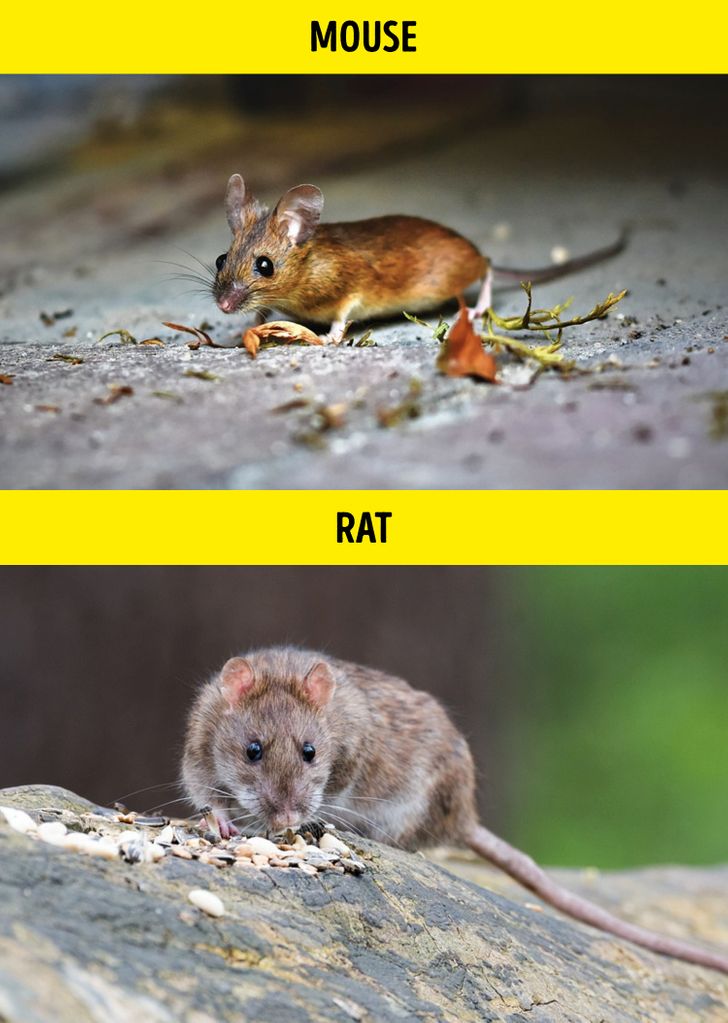
The 2 most famous (or infamous) rodents can be easily distinguished by 3 things: their size, tail, and ears. Mice are diminutive, even compared to young rats; they have thin long tails covered with fur while rats’ tails are thick and hairless. Mice have ears that are bigger in proportion to their bodies and are round and floppy with a tiny, triangular face. Rats’ faces are more prominent and blunt.
14. Seagull vs albatross
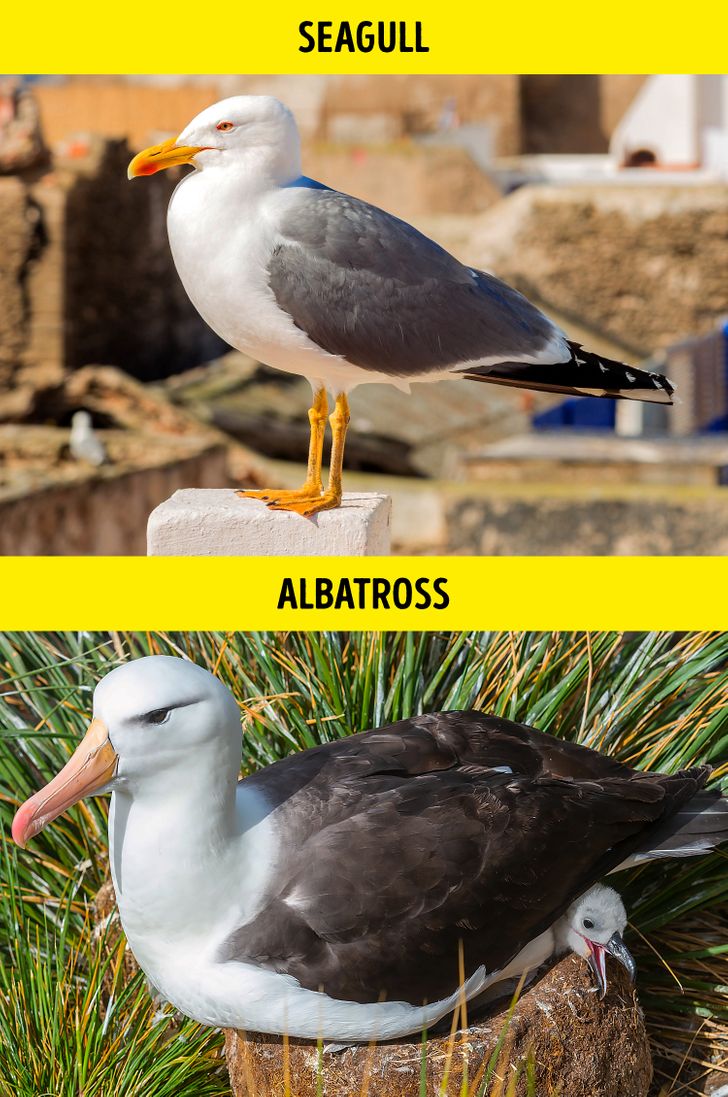
Gulls often live near water, be it the sea or ponds, and are rather acrobatic while diving and fish-catching, but aren’t fans of long voyages, unlike albatrosses. Albatrosses are portly birds who live in constant flight over the sea. They even have unique nostrils that allow them to remove salt from water and food.
15. Wolverine vs honey badger
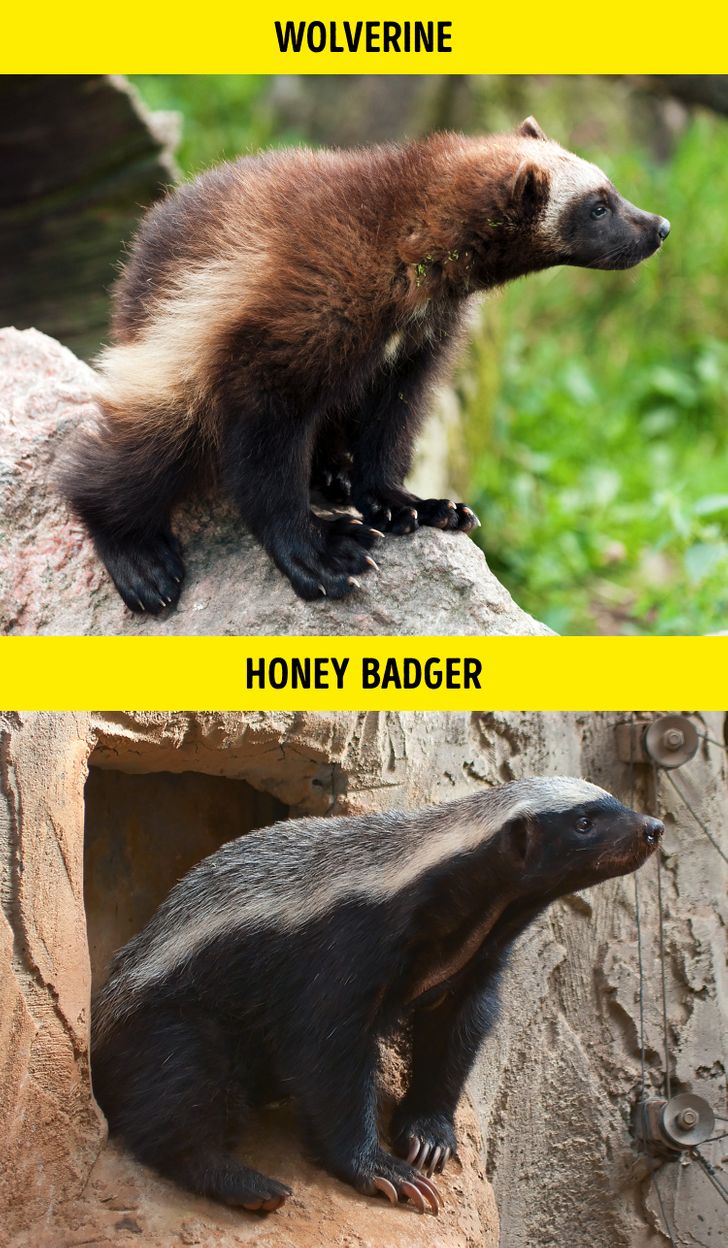
Despite living in different climate zones — the honey badger that lives in Africa and the wolverine that resides in the northern forests — both belong to the Mustelidae family. Wolverines are taller with longer legs and noticeable ears and have brown fur with yellow rings. Honey badgers keep closer to the ground and have black bodies with a white “cape” on their backs.
16. Wolf vs coyote vs jackal
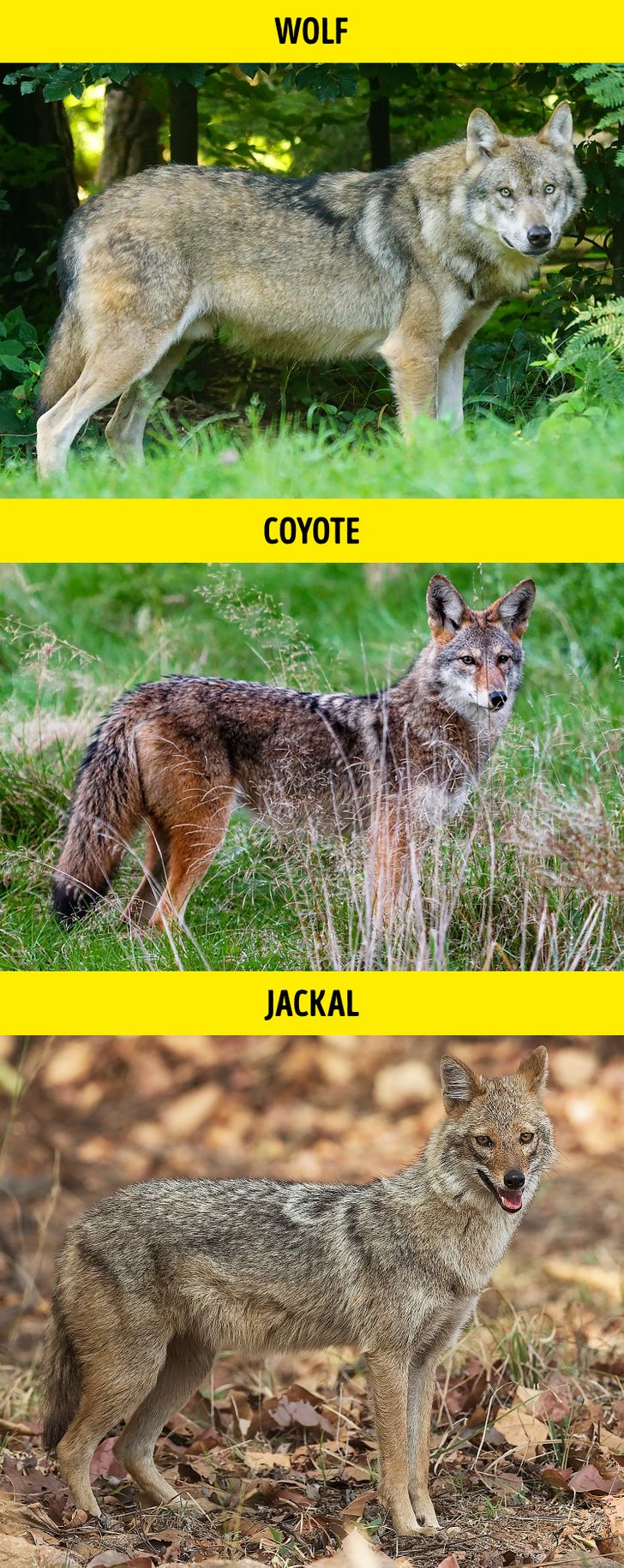
These 3 are “good boys and girls” that parade all over the globe. Jackals live in Africa, Asia, and India; coyotes live in Northern America; and wolves live all over the place. Wolves are large, sturdy animals, while coyotes and jackals possess a more lean and fragile frame.
Coyotes are recognizable for the red fur on their faces and ears while jackals have a more yellow-colored coat. Additionally, jackals are noticeably less fluffy because they don’t have to endure the harshness of winter.
Funny bonus: Wolverine vs the honey badger
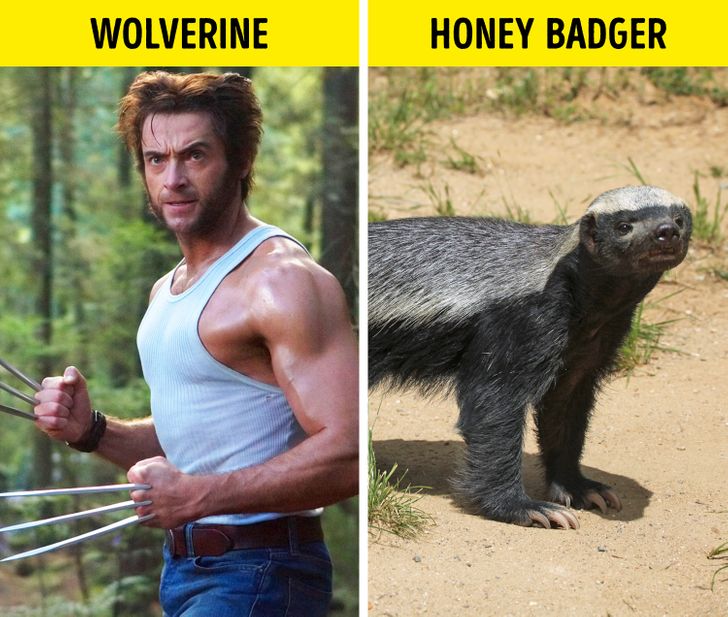
What kinds of animals have ever confused you? If you know more examples, share them in the comments!
Preview photo credit shutterstock.com, shutterstock.com
My Future MIL Stormed Into the Church on Our Wedding Day, Waving a Letter and Objecting to Our Marriage

On what should have been the happiest day of Avril’s life, her future mother-in-law stormed into the church mid-ceremony, clutching a letter and DEMANDING THE WEDDING STOP. What followed wasn’t just a bombshell — it was a WHIRLWIND OF REVELATIONS Avril never saw coming.
Weddings are supposed to be joyful chaos, but mine was headed straight for uncharted territory. Allison, my future mother-in-law, had been nothing but a dream during the wedding preparations. She’d offered me her vintage wedding dress, helped me tailor it, and had a hand in the catering and decorations. I never doubted her care or acceptance of me… not even for a second.
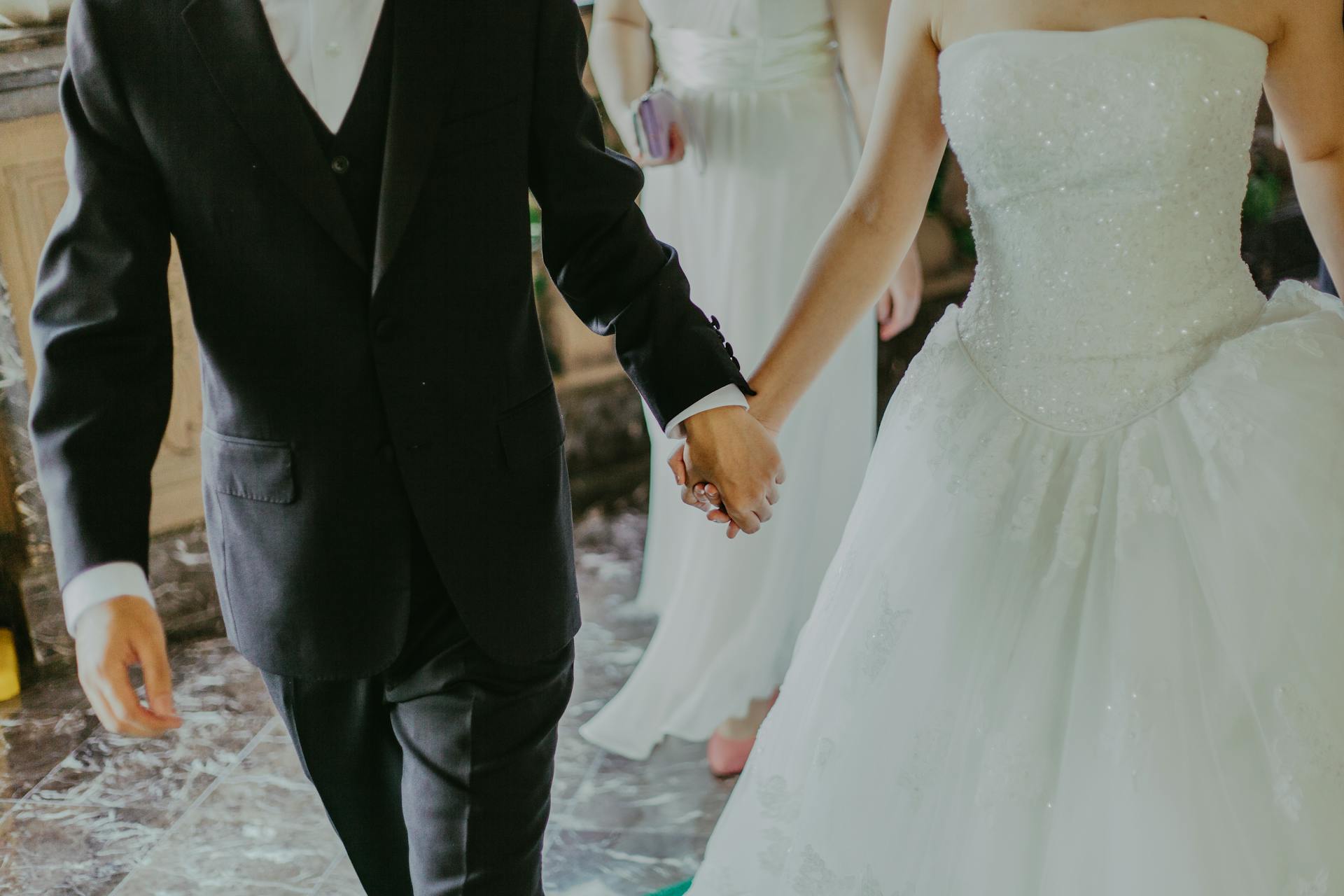
A bride and groom | Source: Pexels
“You look absolutely breathtaking,” she had whispered just hours before the wedding, helping me into her restored vintage gown. “Like this dress was made for you.”
“I can’t thank you enough, Allison,” I’d replied, fighting back tears. “For everything. For making me feel like family already.”
Her eyes had welled up then, and I thought everything would be perfect… until Allison suddenly disappeared during the ceremony. She stormed back into the church, shouting, “STOP IT!” while waving a letter in the air. I felt like the ground had been yanked from under me.
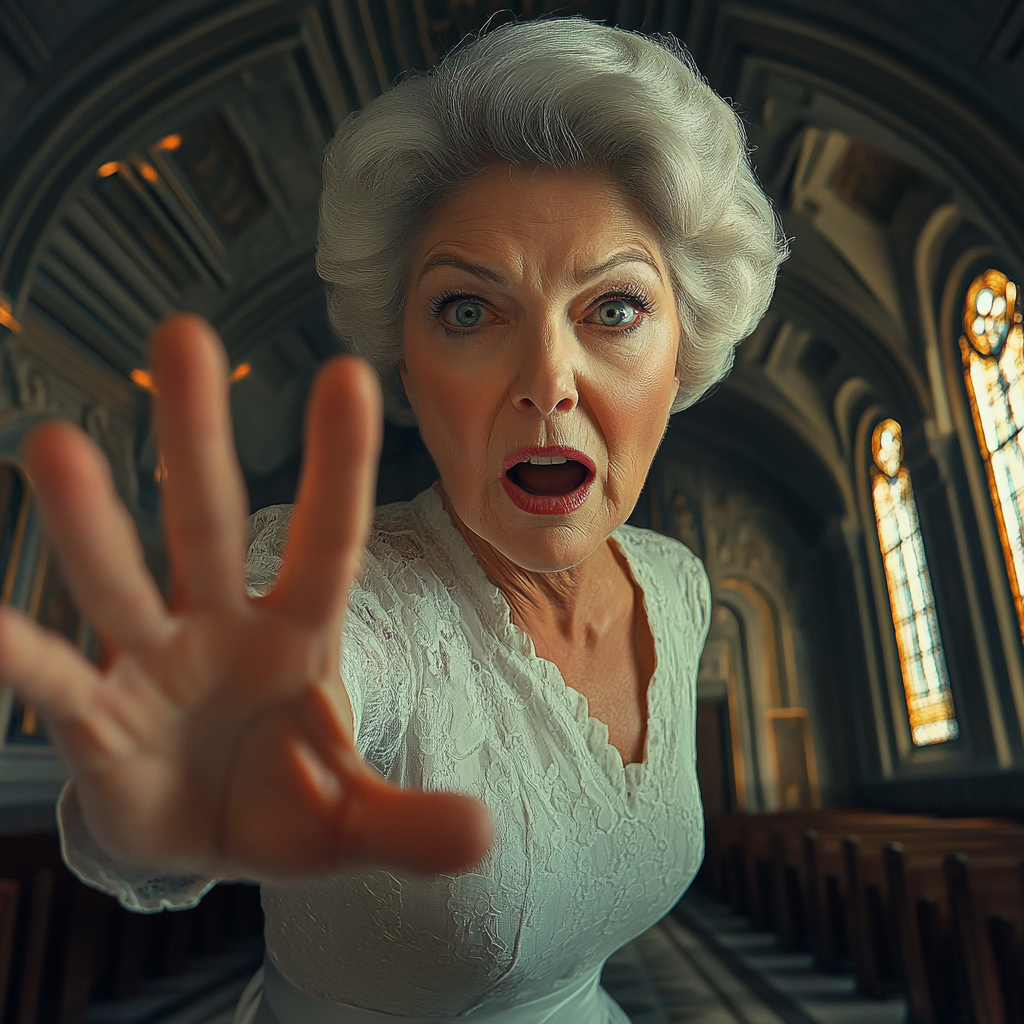
A frantic older woman in a church | Source: Midjourney
The murmurs in the room were deafening as Allison strode toward me, her face blotchy from crying. Tears streamed down her cheeks as she grabbed my hands.
“I’m so sorry,” she choked out, trembling. “I doubted it, but now it’s confirmed.”
I glanced at Sam, my groom, who stood beside me, his face mirroring my confusion. “What’s going on?” I asked, trying to keep my voice steady.
“Mom, please,” Sam whispered urgently, his hand tightening around mine. “Whatever this is, can’t it wait?”
“No,” Allison sobbed, her hands shaking. “No, it can’t wait. Not another minute. Not another second.”

A shocked bride | Source: Midjourney
She turned to the crowd, her voice breaking as she apologized. “I’m so sorry, but I need to explain something important to the bride and groom in private. Sam and Avril, please come outside with me.”
“Avril,” my adoptive father called from the front row, half-rising from his seat. “Do you want me to —”
“It’s okay, Dad,” I managed, though my voice quivered. “We’ll handle this.”
The tension in the room was unbearable. Sam and I exchanged a glance before following her out of the church. My legs felt like lead, and my heart raced as we stepped into the winter sunlight.
The cold air bit at my skin as Allison turned to face us, clutching the letter like a lifeline. “I don’t even know how to say this,” she began, her words stumbling over each other.

A sad older lady holding a letter | Source: Midjourney
“Just tell us,” Sam said. “What’s going on, Mom? Why did you stop the wedding?”
“Sam, please,” I whispered, touching his arm. “She’s clearly upset. Let her explain.”
“A few months after Sam introduced you to me,” Allison began, looking at me, her eyes glistening with tears, “I noticed a birthmark behind your ear. It’s identical to mine.”
Her words didn’t make sense at first. I touched the small birthmark behind my ear instinctively.
“I thought it was just a coincidence,” she continued. “But a few days before the wedding, during dinner, I noticed the birthmark behind your ear again. It was so identical to mine, and I couldn’t shake the feeling. That’s when I made the decision.”
“The decision to do what?” I asked, the chill in my chest growing.
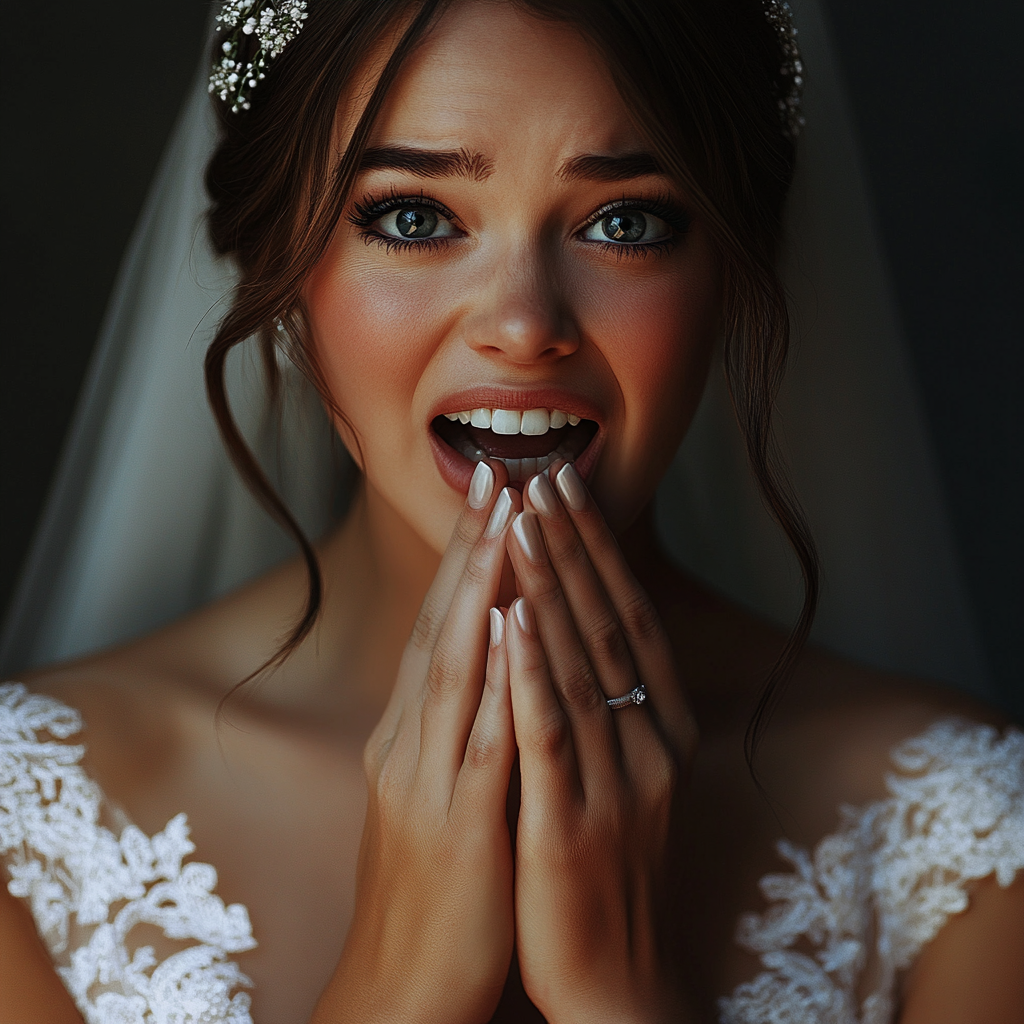
A shocked bride getting emotional | Source: Midjourney
She wiped her tears and looked me directly in the eyes. “That evening, I saw you brushing your hair and putting the brush in your bag. Later, I took a strand of hair from it and sent it for a DNA test. I wasn’t sure if the results would arrive in time, but they came this morning.”
“You did what?” Sam exploded, stepping forward. “Mom, how could you? That’s a complete invasion of —”
“Please,” Allison begged, reaching for his hand. “Please just let me finish.”
My stomach flipped. “A DNA test? Why would you do that? And what are you trying to say?”
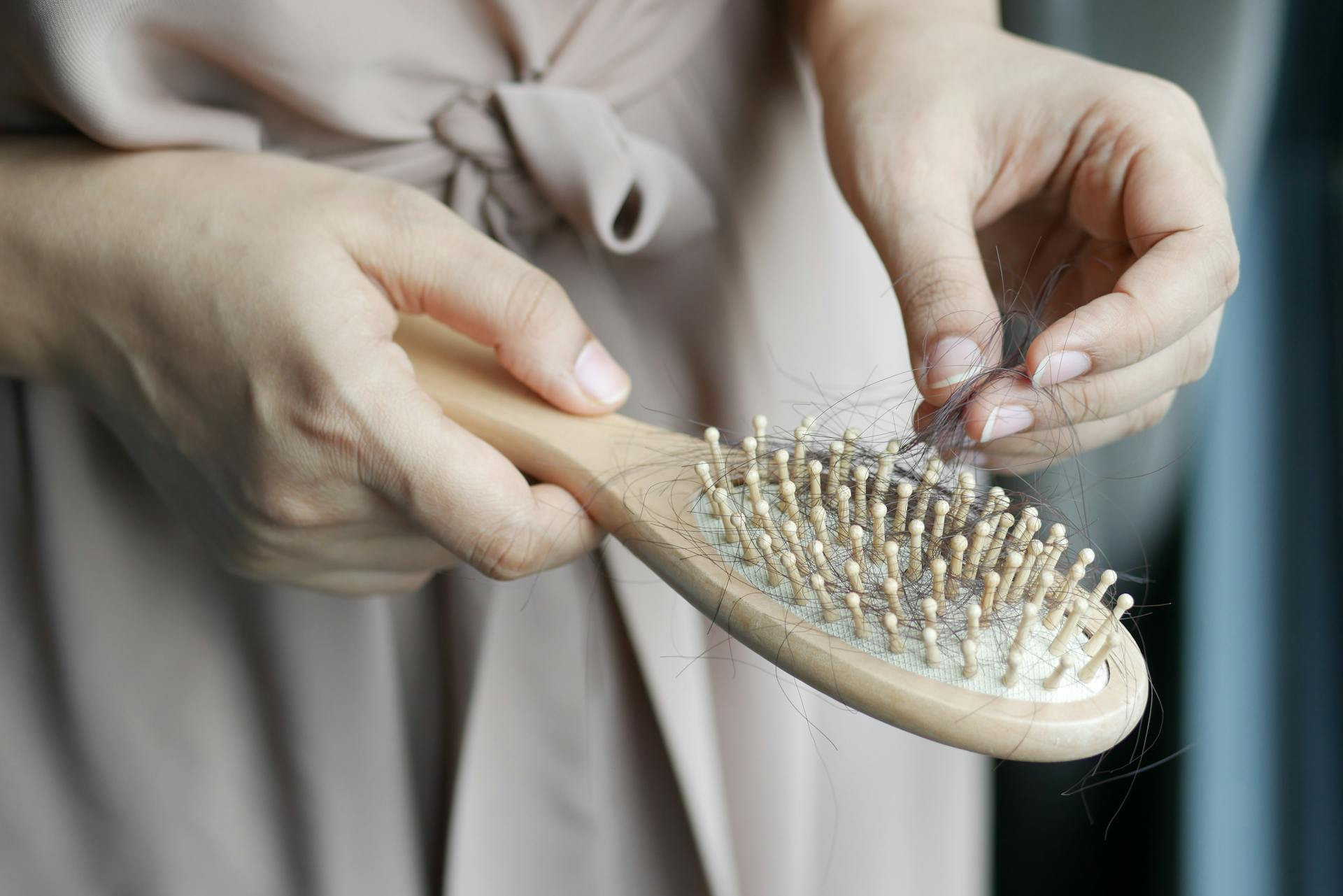
Cropped shot of a woman removing hair from a brush | Source: Pexels
Allison took a deep breath. “When I was 15, I had a baby with a boy I loved in high school… a little girl. Your father ran away the moment I told him I was pregnant. I was young, and my parents forced me to give her up for adoption. I was devastated, but I had no choice. I never stopped thinking about her, but I signed the papers, agreeing I’d never contact her or find out what happened to her. I’ve spent years trying to find my daughter, but I never could… until now.”
My knees buckled. Sam grabbed my arm to steady me, but my mind was reeling.
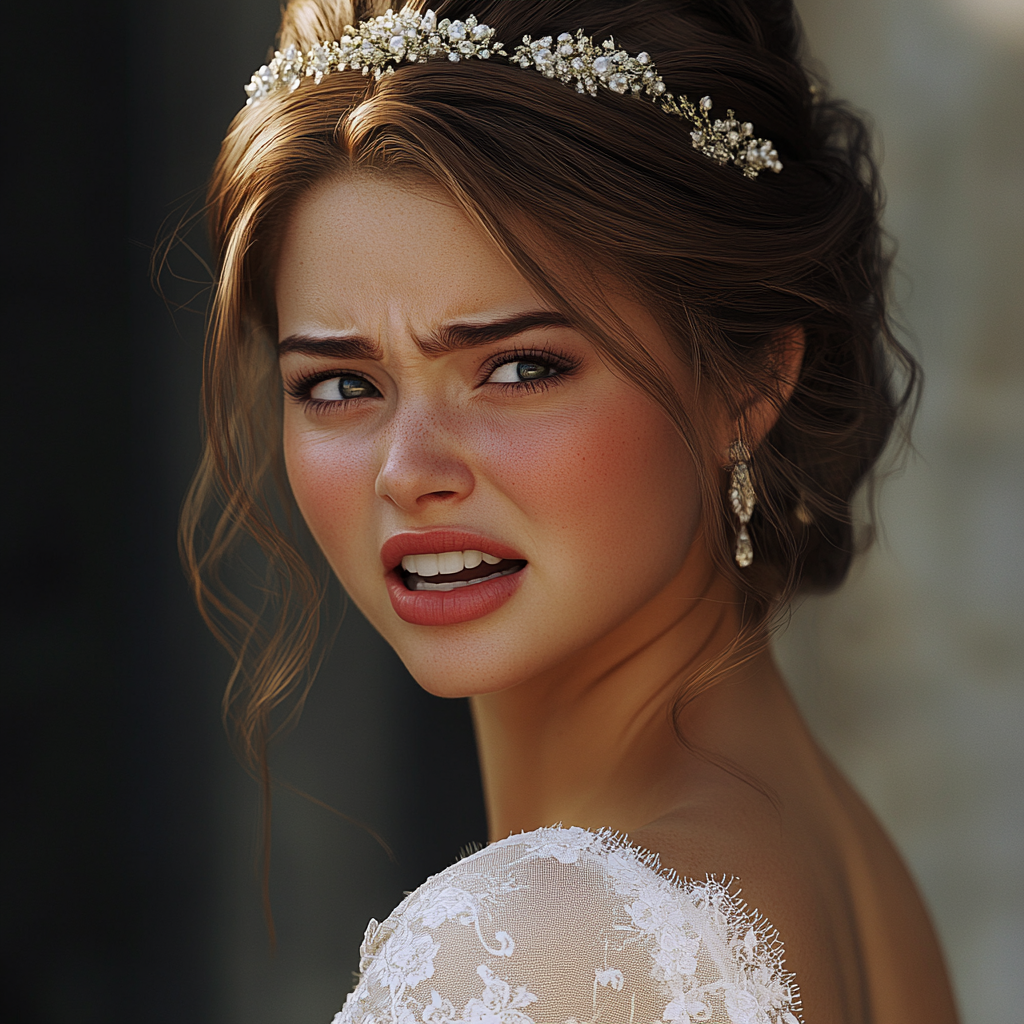
An anxious bride | Source: Midjourney
“You’re my daughter, Avril,” Allison whispered. “You’re the baby I gave up.”
The world tilted. “What?” I gasped. “I’m… YOUR DAUGHTER??”
“The DNA results confirmed it,” Allison said, her voice laced with emotion. “You’re my biological daughter.”
Sam and I stared at each other, and we were horrified.
“Oh God,” I choked out, my hand flying to my mouth. “Oh God, no, no, no… this can’t be.”
“But if you’re my mother,” I stammered, “then that would make Sam my —”
“No!” Allison interrupted, shaking her head. “No, you’re not siblings. Let me explain.”
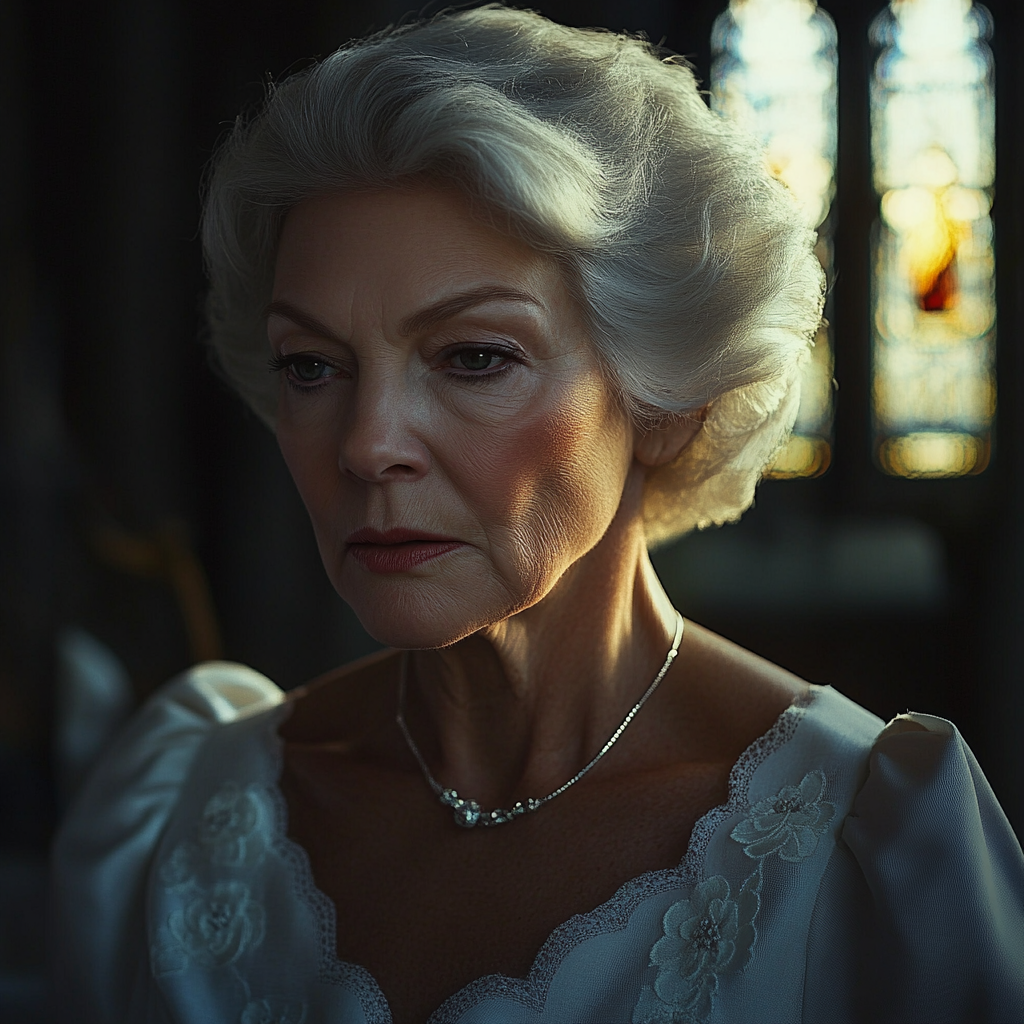
An emotional older woman standing outside a church | Source: Midjourney
“Not siblings?” Sam’s voice cracked. “Mom, what are you saying? This doesn’t make any sense.”
She took a step closer, her hands shaking as she clutched the letter. “When I was 21, I got married. My late husband and I struggled with infertility, so we adopted a little boy. Sam was seven years old when we brought him home. He’s my son in every way that matters, but you and he aren’t related by blood, Avril.”
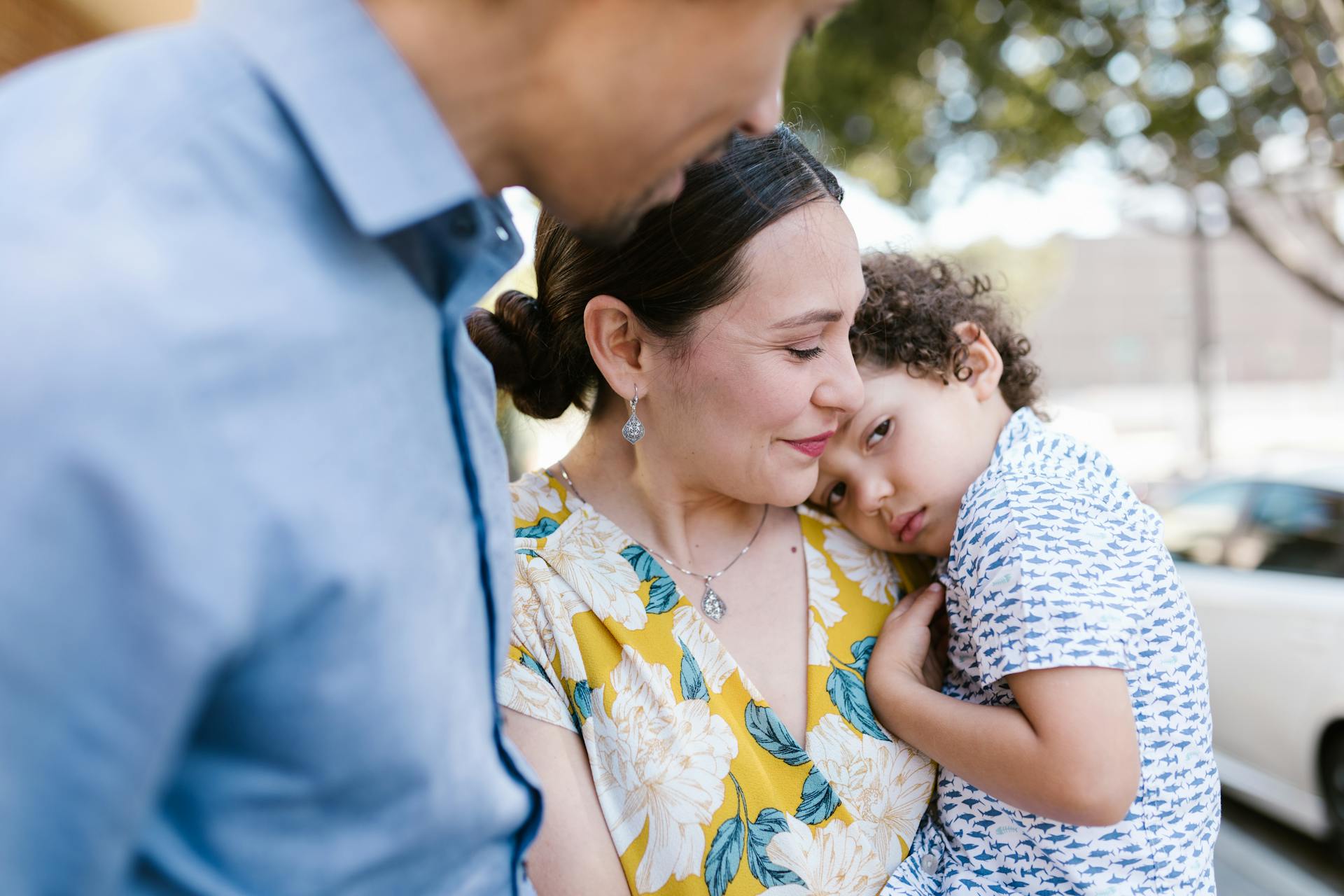
A couple with a little boy | Source: Pexels
Relief washed over me, but it was immediately drowned out by disbelief. Sam was silent beside me, his face pale and eyes brimming with tears.
“I remember that day,” he whispered. “The day you brought me home. You told me I was your miracle.”
“You were,” Allison sobbed, reaching for him. “You are. Both of you are my miracles.”
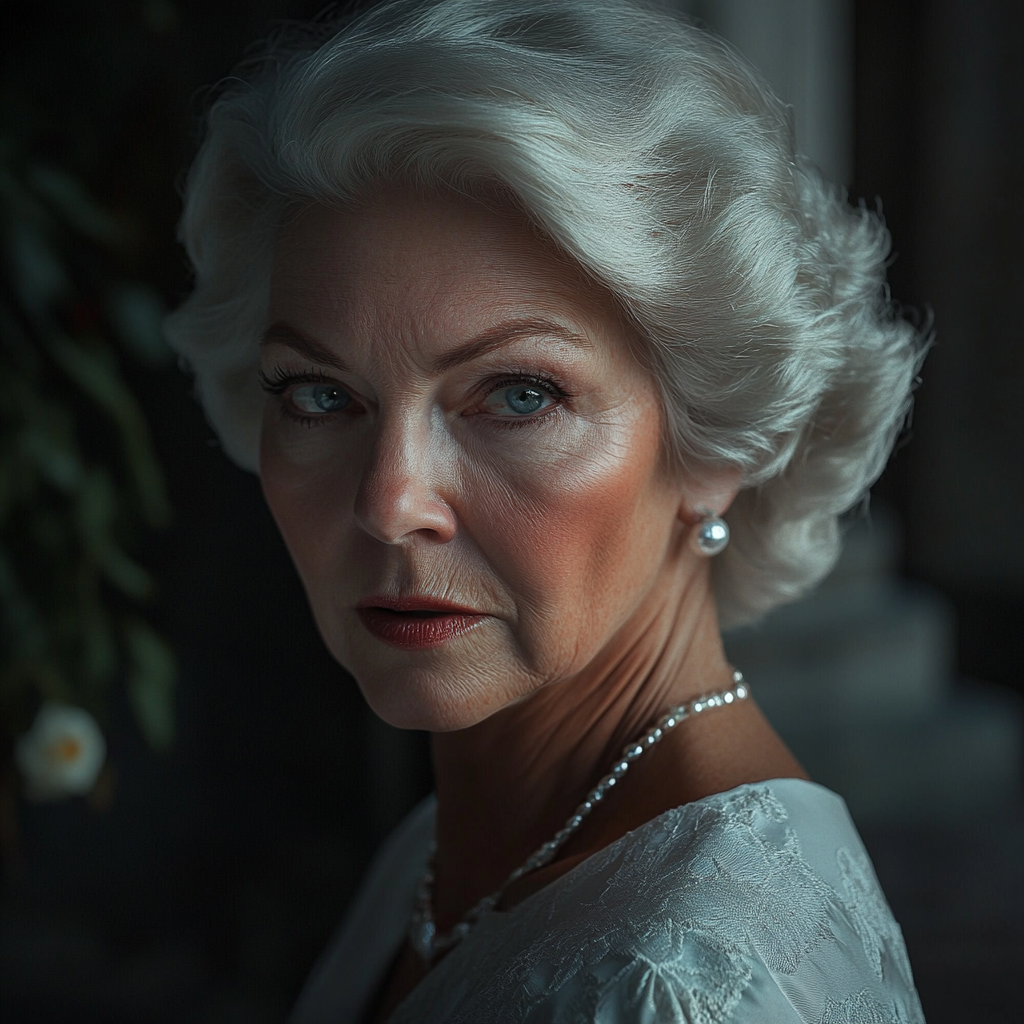
An older lady looking at someone | Source: Midjourney
“I didn’t want to ruin your wedding, Avril. But I had to tell you. You deserved to know the truth before marrying Sam. And now…” Her voice broke, and she covered her face. “Now I don’t just have a daughter-in-law. I have a daughter.”
The rest of the day felt like a blur. We went back into the church and finished the ceremony, but the mood had shifted. I caught glimpses of Allison sitting in the front row, her eyes red from crying.
At the reception, I couldn’t focus on the celebration. My brain was stuck in a loop, trying to make sense of everything. My mother-in-law was my biological mother. My husband wasn’t my brother, but he was still my mother’s son in a way.
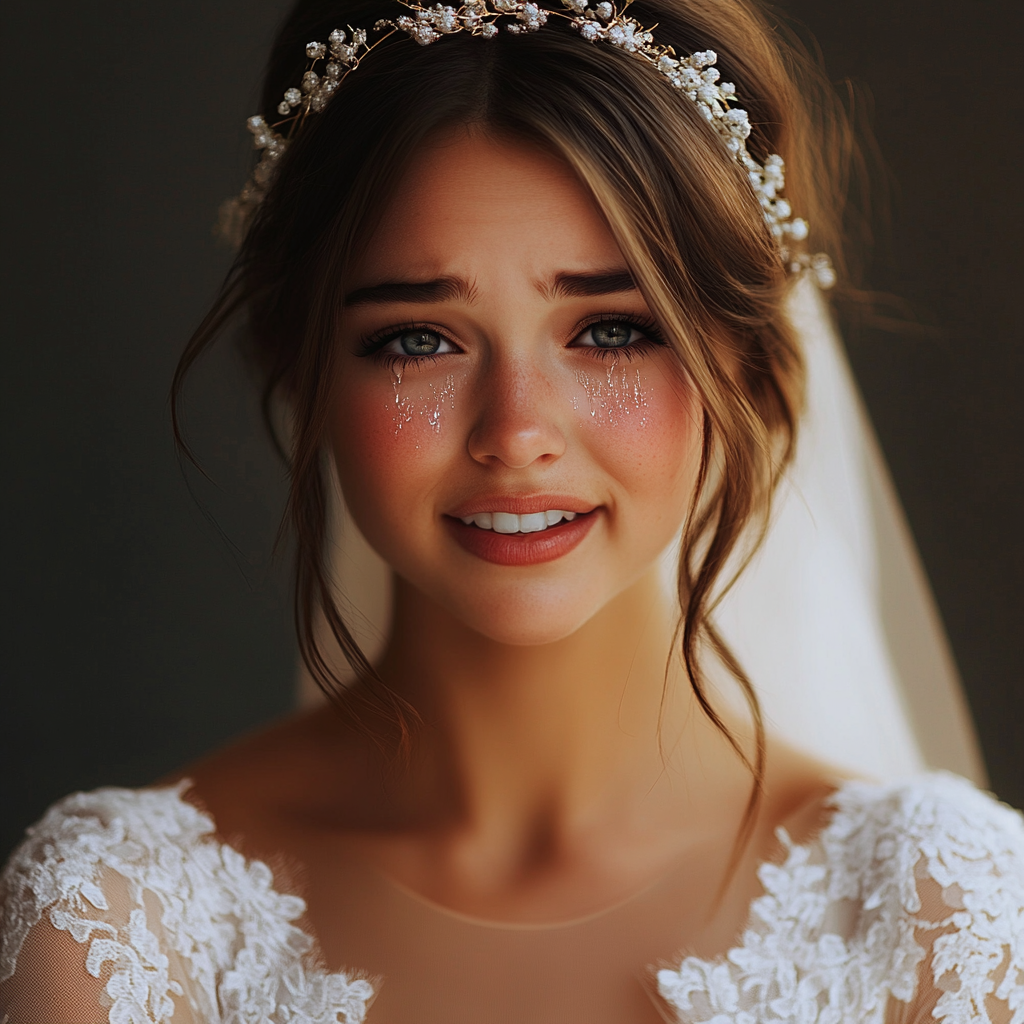
An emotional bride at her wedding reception | Source: Midjourney
“I feel like I’m dreaming,” I whispered to my adoptive father as we shared our dance. “Dad, how is this real?”
He pulled me closer, his voice gruff with emotion. “You’re still my little girl. Nothing changes that. But maybe now you have room in your heart for two mothers?”
As Sam and I danced, he leaned in close. “Are you okay?”
“I don’t know,” I admitted, my voice shaking. “How can any of this be okay?”
“We’ll figure this out,” he said softly, squeezing my hand. “You didn’t just marry me today — you found a piece of your family, too.”
“But what if it changes everything?” I whispered against his shoulder. “What if it changes us?”

A bride and groom holding hands | Source: Unsplash
“Look at me,” he said, tilting my chin up. “Nothing could change how I feel about you. Nothing.”
I looked over at Allison, sitting at her table, watching us with hope and uncertainty. For the first time, I felt something shift in me.
The days after the wedding were filled with long conversations. Allison told me everything — about the guilt she’d carried for years, the desperate searches, and the sleepless nights wondering if her daughter was happy and safe.
“I used to write you letters,” she confessed one evening, pulling out a worn shoebox. “Every birthday and every Christmas. I never knew where to send them, but I couldn’t stop writing them.”
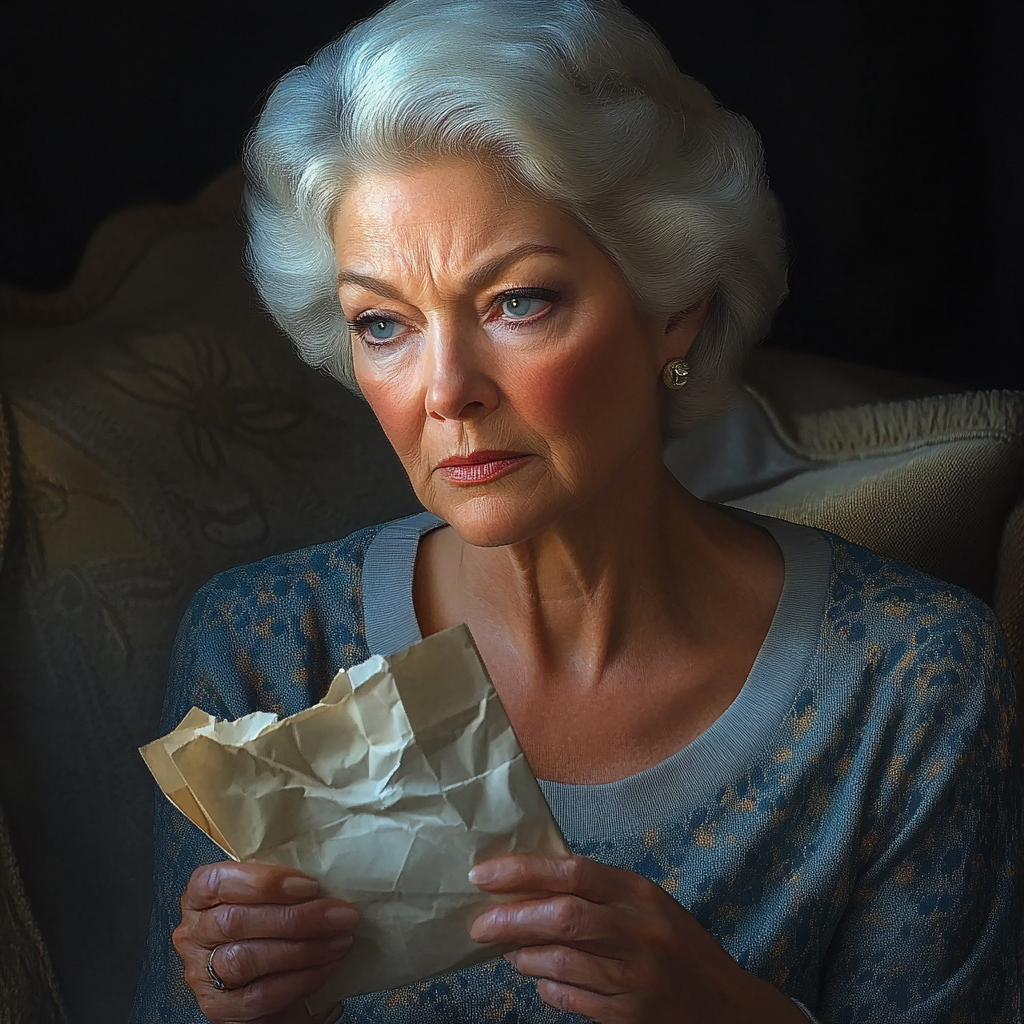
A sad older woman feeling nostalgic as she holds a letter | Source: Midjourney
“Sometimes,” she whispered, “I would see a young woman on the street with long dark hair like yours, and my heart would stop. I’d wonder, ‘Could that be her?’ But I never had the courage to approach anyone.”
“I don’t know how to feel,” I admitted. “This is… a lot.”
“I understand,” she said, tears filling her eyes. “Take all the time you need. I’m just so grateful you’re in my life now.”
And strangely, I was also grateful.
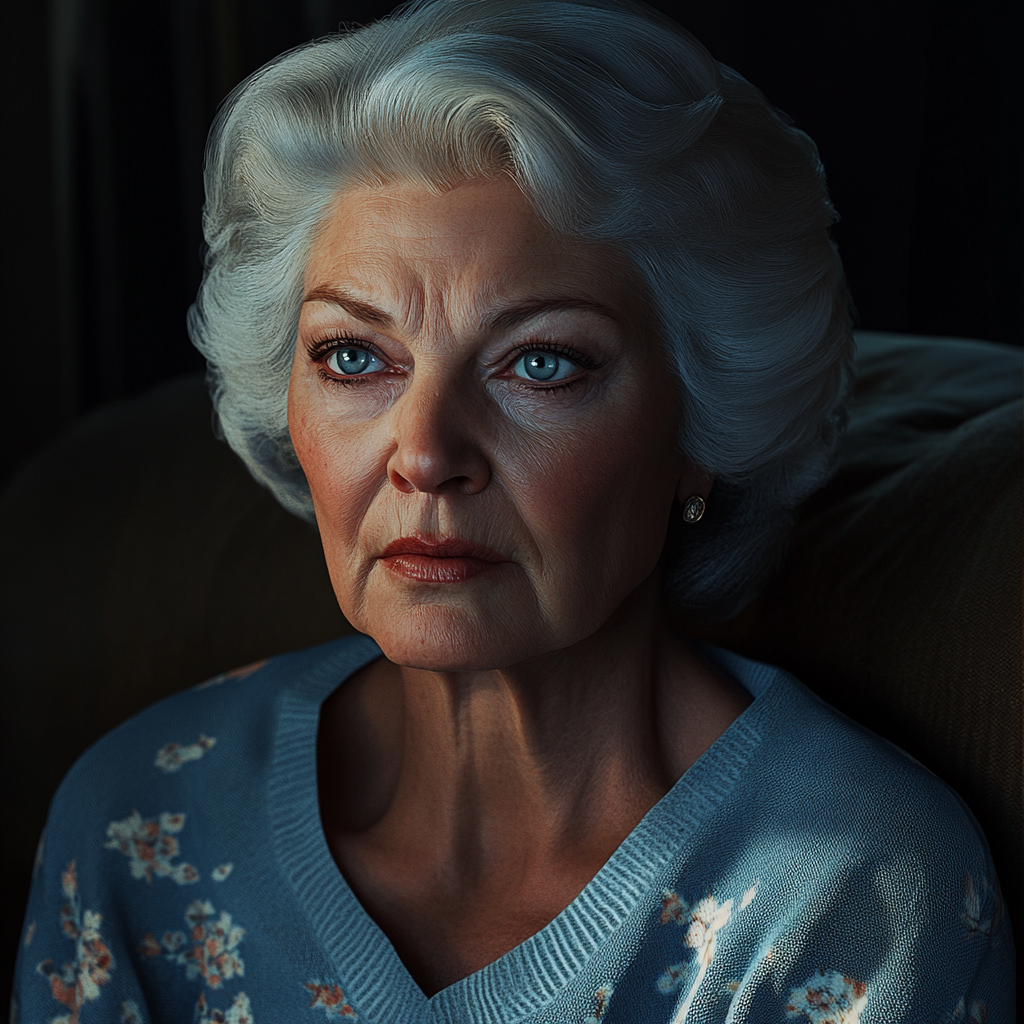
A sad older woman sitting on the couch | Source: Midjourney
A few weeks later, Allison came over for dinner. As we sat around the table, laughing and sharing stories, I realized something: family isn’t always about how you get there. Sometimes, it’s about what you do once you arrive.
“Do you remember,” Sam asked, grinning at his mother, “that time you caught me trying to mail myself to Disney World?”
“In a cardboard box!” Allison laughed, wiping tears from her eyes. “You’d packed a sandwich and everything!”
“Thank you for giving me my son back,” she said as we cleared the dishes.
“And thank you for giving me the mother I never knew I had,” I replied.

An emotional woman with a sweet smile | Source: Midjourney
“I have something for you,” she said suddenly, pulling an envelope from her purse. “It’s the first letter I ever wrote to you. I wrote it the day they took you away.”
My hands trembled as I took it. “I don’t know if I’m ready to read it yet.”
“That’s okay,” she smiled, squeezing my hand. “We have time now. All the time in the world.”
Sam walked into the room, placing a hand on my shoulder. “Looks like I married into one complicated, beautiful family,” he said with a grin.
“The best kind,” I replied, looking between my husband and the woman who was both my mother-in-law and my mother.
And for the first time, I realized he was right. Complicated, yes… but beautiful all the same.

A romantic couple | Source: Unsplash
This work is inspired by real events and people, but it has been fictionalized for creative purposes. Names, characters, and details have been changed to protect privacy and enhance the narrative. Any resemblance to actual persons, living or dead, or actual events is purely coincidental and not intended by the author.
The author and publisher make no claims to the accuracy of events or the portrayal of characters and are not liable for any misinterpretation. This story is provided “as is,” and any opinions expressed are those of the characters and do not reflect the views of the author or publisher.
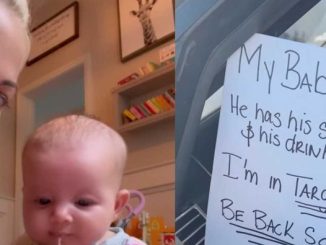
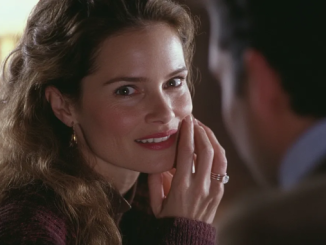
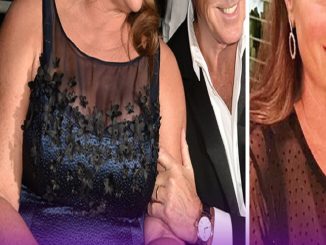
Leave a Reply